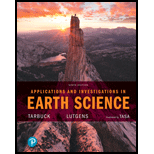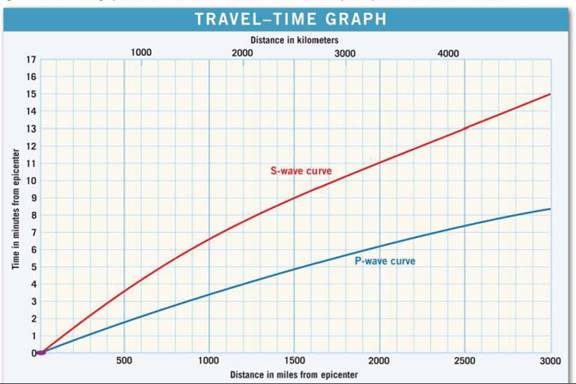
Applications and Investigations in Earth Science (9th Edition)
9th Edition
ISBN: 9780134746241
Author: Edward J. Tarbuck, Frederick K. Lutgens, Dennis G. Tasa
Publisher: PEARSON
expand_more
expand_more
format_list_bulleted
Textbook Question
Chapter 4.2A, Problem 1A
Examine Figure 4.41 Does the difference in the arrival times of the first P wave and the first S wave on a seismogram Increase or decrease the farther a station IS from the epicenter?
The difference in arrival times _____ the farther a station is from the epicenter
Figure 4.4 Travel-time graph used to determine the distance between an earthquake epicenter and a seismic station.

Expert Solution & Answer
Trending nowThis is a popular solution!
Learn your wayIncludes step-by-step video

schedule04:57
Students have asked these similar questions
Choose two vehicles to compare. One being a gas powered one being electric. No hybrids. With the media of your choosing compare and contrast the two vehicles emissions and pollution factors. Key words are Hydrocarbon, Carbon, Hydrogen, Asthma, Infection, Pollution, and Global warming.
Evaluate the advantages and disadvantages of gas and electric cars.
charles darwin, what did he do
Chapter 4 Solutions
Applications and Investigations in Earth Science (9th Edition)
Ch. 4.1 - How many minutes elapsed between the arrival of...Ch. 4.1 - How many minutes elapsed between the arrival of...Ch. 4.1 - How much time elapsed between the arrival of the...Ch. 4.1 - Is the maximum amplitude wave height of the...Ch. 4.2A - Examine Figure 4.41 Does the difference in the...Ch. 4.2A - Use Figure 4.4 to determine the difference in...Ch. 4.2A - What is the distance between the epicenter and the...Ch. 4.2A - For the earthquake recorded in Figure 4.2, about...Ch. 4.2A - If the first P wave was recorded at 10:39 P.M....Ch. 4.2B - Use Figure 4.5 and the travel-time graph in Figure...
Ch. 4.2B - Use Figure 4.6 and a drafting compass to draw a...Ch. 4.2B - What are the approximate latitude and longitude of...Ch. 4.2B - The first P wave was recorded in New York at 9:01...Ch. 4.3 - Use Figure 4.7 to answer the following questions a...Ch. 4.3 - At what depth shallow, Intermediate, or deep do...Ch. 4.3 - With what geologic feature are the earthquakes in...Ch. 4.3 - What name is given to the zone of greatest seismic...Ch. 4.4 - Does the velocity of P waves and S waves increase...Ch. 4.4 - What are the approximate velocities of P and S...Ch. 4.4 - Does the velocity of P waves and S waves increase...Ch. 4.4 - Does the change in velocity of seismic waves as...Ch. 4.4 - How does the velocity of seismic waves change with...Ch. 4.4 - Does the change in velocity of seismic waves with...Ch. 4.4 - What happens to S waves when they reach the outer...Ch. 4.4 - Do P waves increase or decrease in velocity as...Ch. 4.4 - What are the approximate velocities of P and S...Ch. 4.4 - What are the approximate velocities of P and S...Ch. 4.4 - Prob. 11ACh. 4.5 - Plot the temperature values from Table 4.2 on the...Ch. 4.5 - Referring to the graph, does Earth sinternal...Ch. 4.5 - Is the rate of temperature Increase from the...Ch. 4.5 - Is the temperature at the base of the lithosphere,...Ch. 4.6 - Plot the melting temperatures for wet granite and...Ch. 4.6 - At approximately what depth does wet granite reach...Ch. 4.6 - Oceanic crust and the underlying rocks to a depth...Ch. 4.6 - Referring to Figure 4.10, at approximately what...Ch. 4.6 - Referring to Figure 4.9, what is the name of the...Ch. 4.6 - Does the graph you constructed support or refute...Ch. 4 - Explain the difference between a seismograph and a...Ch. 4 - Use Figure 4.11 to sketch a typical seismogram in...Ch. 4 - Use Figure 4.4 and Figure 4.11 to determine the...Ch. 4 - List the three zones around the globe where most...Ch. 4 - The velocity of S waves decreases as these waves...Ch. 4 - Explain why S waves do not travel through Earths...Ch. 4 - Use Figure 4.8 to complete the following about...Ch. 4 - Prob. 8LRCh. 4 - What is the location directly above an earthquake...Ch. 4 - Label Earths major layers on Figure 4.12, using...
Additional Science Textbook Solutions
Find more solutions based on key concepts
Why are the top predators in food chains most severely affected by pesticides such as DDT?
Campbell Essential Biology (7th Edition)
Endospore formation is called (a) _____. It is initiated by (b) _____. Formation of a new cell from an endospor...
Microbiology: An Introduction
1. a. Can a vector have nonzero magnitude if a component is zero? If no, why not? If yes, give an example.
b. C...
College Physics: A Strategic Approach (3rd Edition)
Why do researchers identify the charophytes rather than another group of algae as the closest living relatives ...
Campbell Biology (11th Edition)
123. A sample contains both KBr and KI in unknown qualities. If the sample has a total mass of and contains , ...
Introductory Chemistry (6th Edition)
Name each of the following:
Organic Chemistry (8th Edition)
Knowledge Booster
Similar questions
- While Chapters 8 and 9 consider almost purely endogenic processes, Chapter 10 takes us further out from the center of the Earth to exogenic processes. My sister and I were out for a walk when we decided to cut through the cemetery. I could not help but wonder why the tombstones below are so different. While both tombstones are roughly the same age, the top one is made out of limestone while the bottom one is made out of granite. However, the one above looks much older due to a difference in the rate of weathering. Limestone is made out of the mineral calcite, CaCO3, calcium carbonate. Reads "1884" Dieds JOSEPH HERRING 1842-1911 JULIA HERRING 1843 NELLIE HERRING 1870-1882 Reads "1882" The tombstone in better condition here is made out of granite. Granite contains minerals such as quartz and feldspar. Both tombstones experience the same climate conditions and have been exposed to exogenic processes for the same amount of time yet they look so different! Some research into Chapter 10…arrow_forwardDiscussion Question: Tectonics, Earthquakes and Volcanism A+ The image below can also be found in your textbook. This image is not an interpretation but an actual picture of the Red Sea. This area of the world is the East African Rift Zone separating Saudi Arabia and Africa. The linear pattern is due to extensional tectonics. In other words, Africa and Saudi Arabia are moving away from each other creating tensional forces that create normal faults. The landscape features found in the area are Rift Valleys. Pretend we are on location at the East African Rift Valley. We would find Normal Faults where one side of the fault shows a rock layer dropped relative to the other layer. We would find linear mountains that formed from the valley dropping out between the normal faults. The microscale evidence we collect helps to add up to the macroscale interpretation of a divergent boundary due to tensional forces creating normal faults and rift valleys.arrow_forwardPlease explain why low clouds occur off of California’s coast during summer. In your explanation, please include the terms “Hadley Circulation,” “atmospheric subsidence,” and “ocean upwelling''arrow_forward
- In Sequoia National Park, why does soil moisture increase in April even though precipitation totals are on average lower in April than in March?arrow_forwardThe continents are net importers of precipitation from the oceans. We know this because, while only 15% of global evaporation occurs from the continents, the continents receive 23% of the globe’s precipitation. How is this discrepancy sustainable without the continents filling up with water and the oceans emptying out?arrow_forward6) Just 15% of global evaporation occurs over the continents even though the continents cover about 29% of the earth’s surface. Why is the proportion of global evaporation that occurs on continents less than 29%?arrow_forward
- What are the four elements of a local water budget ? Assuming all else is held equal, what is the effect of warming on the atmosphere’s ability to evaporate water from soils and vegetation? What happens to the amount of water stored in the soil if warming affects evapotranspiration in the way you described above and there is no change to runoff?arrow_forwardThe map below shows the age of the ocean floor (time since the crust was formed). Why do we find the youngest ocean crust at the mid-ocean ridges? Why does the oldest crust tend to be near continental coasts?arrow_forwardwhat is a main piece of evidence that the continents were once all connected in a single super continent 200–300 million years ago? What was the main role of plate tectonics in breaking up this super continentarrow_forward
- What might occur when humans overuse the natural resources of a space or habitat? Question 2 options: Environmental Stability Species Extinction Resource Regeneration Ecological Deficitarrow_forwardWhat does natural capital include? Question 3 options: Water, Land, Air Renewable resources Non-renewable resources Culture heritagearrow_forwardNatural Gas is a renewable natural resource. Question 1 options: True Falsearrow_forward
arrow_back_ios
SEE MORE QUESTIONS
arrow_forward_ios
Recommended textbooks for you
 Applications and Investigations in Earth Science ...Earth ScienceISBN:9780134746241Author:Edward J. Tarbuck, Frederick K. Lutgens, Dennis G. TasaPublisher:PEARSON
Applications and Investigations in Earth Science ...Earth ScienceISBN:9780134746241Author:Edward J. Tarbuck, Frederick K. Lutgens, Dennis G. TasaPublisher:PEARSON Exercises for Weather & Climate (9th Edition)Earth ScienceISBN:9780134041360Author:Greg CarbonePublisher:PEARSON
Exercises for Weather & Climate (9th Edition)Earth ScienceISBN:9780134041360Author:Greg CarbonePublisher:PEARSON Environmental ScienceEarth ScienceISBN:9781260153125Author:William P Cunningham Prof., Mary Ann Cunningham ProfessorPublisher:McGraw-Hill Education
Environmental ScienceEarth ScienceISBN:9781260153125Author:William P Cunningham Prof., Mary Ann Cunningham ProfessorPublisher:McGraw-Hill Education Earth Science (15th Edition)Earth ScienceISBN:9780134543536Author:Edward J. Tarbuck, Frederick K. Lutgens, Dennis G. TasaPublisher:PEARSON
Earth Science (15th Edition)Earth ScienceISBN:9780134543536Author:Edward J. Tarbuck, Frederick K. Lutgens, Dennis G. TasaPublisher:PEARSON Environmental Science (MindTap Course List)Earth ScienceISBN:9781337569613Author:G. Tyler Miller, Scott SpoolmanPublisher:Cengage Learning
Environmental Science (MindTap Course List)Earth ScienceISBN:9781337569613Author:G. Tyler Miller, Scott SpoolmanPublisher:Cengage Learning Physical GeologyEarth ScienceISBN:9781259916823Author:Plummer, Charles C., CARLSON, Diane H., Hammersley, LisaPublisher:Mcgraw-hill Education,
Physical GeologyEarth ScienceISBN:9781259916823Author:Plummer, Charles C., CARLSON, Diane H., Hammersley, LisaPublisher:Mcgraw-hill Education,

Applications and Investigations in Earth Science ...
Earth Science
ISBN:9780134746241
Author:Edward J. Tarbuck, Frederick K. Lutgens, Dennis G. Tasa
Publisher:PEARSON

Exercises for Weather & Climate (9th Edition)
Earth Science
ISBN:9780134041360
Author:Greg Carbone
Publisher:PEARSON

Environmental Science
Earth Science
ISBN:9781260153125
Author:William P Cunningham Prof., Mary Ann Cunningham Professor
Publisher:McGraw-Hill Education

Earth Science (15th Edition)
Earth Science
ISBN:9780134543536
Author:Edward J. Tarbuck, Frederick K. Lutgens, Dennis G. Tasa
Publisher:PEARSON

Environmental Science (MindTap Course List)
Earth Science
ISBN:9781337569613
Author:G. Tyler Miller, Scott Spoolman
Publisher:Cengage Learning

Physical Geology
Earth Science
ISBN:9781259916823
Author:Plummer, Charles C., CARLSON, Diane H., Hammersley, Lisa
Publisher:Mcgraw-hill Education,